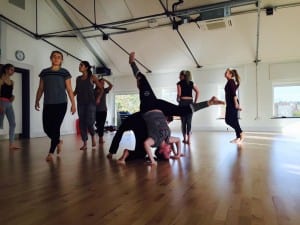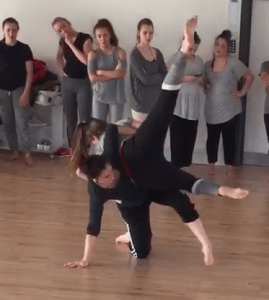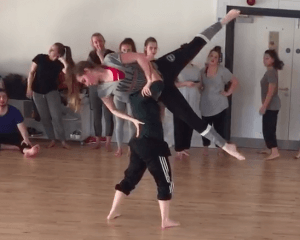I found this week’s reading, ‘What’s The Score?’ by Maura Keefe very interesting and enlightening. We looked into scores last year during improvisation, but we haven’t considered scores within the art of contact improvisation, so to read something that is an example of a score within contact improvisation was very alluring. Keefe not only gives us a detailed description of this score but she also enlightens his readers with information that I haven’t yet thought about within contact improvisation. Keefe relates CI to everyday life. She talks about how it is something we witness and take part in everyday, although she is a rare participant in contact improvisation, it is something she observes a lot which sometimes can be a more interesting perspective than engaging in it. Our perception of CI can sometimes give us a different look on life, it can change the way we view certain things, not only does it change your theory of dance and improvisation, but also everyday life. “Improvisation happens everywhere. Applying concepts about improvisation that have been theorized about dance can be expanded to examine other physical practices to broaden our definitions of both dance and improvisation” (Keefe, 2003, 234).
This week we explored different frames we could use to make contact and complete weight baring lifts with. We explored body to body connections I hadn’t before, for example, the front to front connection, the use of your torso and pelvis. I have never even thought to explore this area of my body before and today I learnt why. I found it extremely challenging. I found myself thinking of what to do rather than it just coming to my body, I established that this was quite difficult to initiate movement by myself let alone with another body. We were very much left to our own devices this lesson, we were left to explore our own individual creativity, but coming up with new movement to do whilst having that front to front connection turned out to be a lot more challenging than I thought. Something I learnt was that our own individual improvising is just as important as improvising with somebody else. Also that our own creativity is just as important or maybe even more essential than performing already known material. Improvising can be very personal, so using our own inventiveness encourages artistic improvisation.
We then explored finding different points of balance on another person’s body. One person was stable, whilst the other found new and interesting ways to counter balance on that person. The objective was to eventually feel and move as one, have that idea of exploration between two bodies using mutual exchange of weight. We spent a bit of time finding possibilities for weight baring with each frame and once we exhausted that frame, we moved onto the next. Something as a class we need to think about is improving our entrances and exits out of movement, and this was time to work with that. Whilst in these weight baring positions we explored getting out of the movement by the lifter going with the leftie, this encouraged us to do it safety and in an effective way. I found that this also encouraged me to go into a next movement efficiently because the fluidity of the last lift transition makes it easier to flow into something else, rather than stopping one contact movement and creating a new frame to go into the next.
Sometimes I don’t know the potential of my own body, especially small, unappreciated parts such as the knee. In this session I found out that as a lifter, my knee can hold a lot of support and aid a lot of movement, and also as a leftie the knee offers a lot of movement opportunity. This partner exercise turned into quite a successful exploration of new movement, but something I found difficult during this task was to stay connected to my partner. I would explore movement over my partner’s knee, and because this process was experimental I sometimes lost my balance therefore causing me to fall one way and my partner not being able to fall with me. Something I need to work on at certain points is fully releasing my body. At times I am completely released but at other times I get a little bit scared and tense my body, making the contact of improvisation very difficult. Something else to note is making sure that I know where my weight is placed, so the movement isn’t ‘clunky’, making my movement fluid is a main point I need to work on.
For the last part of the lesson we did a jam type situation, but for this jam there was a slight difference. Usually we have no restrictions but this time, a minimum of 2 people had to be in the space and a maximum of 4, but when it came to movement, no restrictions were put into place. Points we were given before this jam started was to not rely on the same people to fill the space, or pick up the pace / energy throughout the jam, we were instructed to try and pick up the pace as a collective. Although I entered the space willingly and enjoyed my time in the space, I didn’t like this style of jam… I felt slightly more exposed than usual, because I felt that more eyes were on me and I also felt pressure to get things right. But then the whole right or wrong factor came into play and I started to pick up the pace along with my confidence.
This week’s jam was very different to a previous jam’s. I felt a lot more confident this week and I feel that this was evident within my performance. I treated this jam as an experiment, a place for me just to try out new movement in order to improve my confidence when it comes to CI. I set the bar too high for myself, get my expectations up and I tend to not succeeded as much as I do. So going in with the mind set of playing and experimenting with my movement gives my mind or body no limits or expectations succeeding in a positive outcome.
“Using an understanding of structured improvisation, we can move beyond the familiar frame of dance and consider the embodiment of other improvisational practices” (Keefe, 2003, 237).
Keefe, M. What’s the score? Improvisation in Everyday Life. In Albright, A. C., & Gere, D. (2003). Taken by surprise: A dance improvisation reader. Middletown, Conneticut: Wesleyan University Press.













